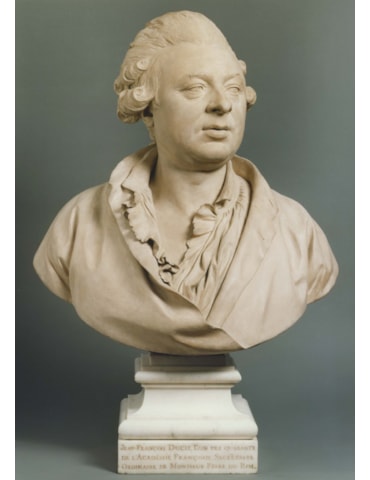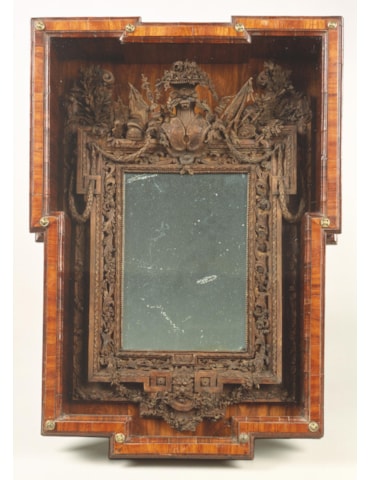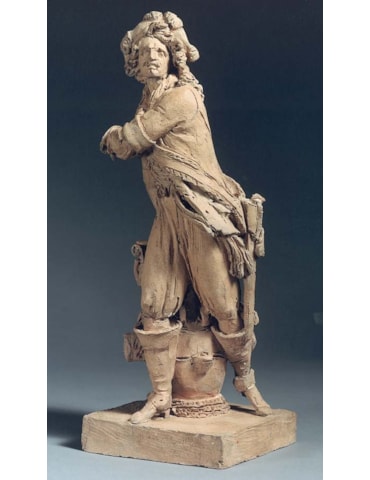Jérôme Duquesnoy the Younger
Brussels 1602 - Ghent 1654
The Infant Hercules Struggling with a Serpent
White marble group
Height: 99 cm - 39 in
Width across base: 42 cm - 16½ in
Height: 99 cm - 39 in
Width across base: 42 cm - 16½ in
ENQUIRIES
+44 (0)20 7259 0707
Provenance: Guccio Gucci S.p.a., Florence
Condition: Slightly weathered and with minor losses to the serpent's tail feathers. Top beak and tip of the lower beak replaced.
Infant Hercules is extremely close in style and subject to a nine-feet-high (2.75-meter) marble statue of Ganymede and the eagle by Jérôme II Duquesnoy, now in Westfälisches Landesmuseum, Münster (D651), which was owned by Jan Lucas Faydherbe (1654-1704), who had been given it by his father, Lucas Faydherbe1 following their collaboration on the high altar at the Cathedral of Sant Romnaut, Malines. The younger Faydherbe was installing Ganymede in the pleasure garden of his newly-built house on the Bruul, Malines in 1704, when he was fatally injured by the collapse of scaffolding. A drawing of Ganymede bears an inscription stating that Jérôme Duquesnoy invented the composition and this provides a firm basis for also attributing the present marble to him.2
Duquesnoy is known to have cast mythological statues in lead for the gardens of the Brussels Palace, including a Hercules and an Eagle.3 Furthermore, the posthumous inventory of the property of Jean-Henry Gobelinus, canon of Sainte-Gudule in Brussels and a member of Spanish court circles, mentions an Eagle and two Ganymedes by “de Quesnoy”. 4
In the Musées royaux des Beaux-Arts in Brussels, there is a terracotta group of Hercules struggling with a serpent by Dusquesnoy. 5 The head of the serpent attacking Hercules is close to drawings of dragons by anonymous Netherlandish masters, also in the Van Herck collection6, and Artus Quellinus incorporated such motifs in reliefs for the New Town Hall in Amsterdam.
The theme of the infant Hercules strangling snakes is recorded by Theocritus. Hercules was the son of Alcmena, a mortal woman, and Jupiter - one of the many occasions on which Jupiter was unfaithful to his wife, Juno. That is why Juno was hostile towards Hercules from birth and she sent poisonous snakes to kill the infant. Hercules’s courage and enormous strength enabled him to strangle the snakes, the earliest test of his heroic powers. The theme of the infant Hercules struggling with one or several serpents appears in classical art, but also in the work of 17th century sculptors such as Ercole Ferrata. The inclusion of Jupiter as an eagle in the present marble is, however, extremely rare and it is a significant addition to the previously known iconography of the subject.7
Biographical Note:
Jérôme Duquesnoy and his elder brother, François, probably received their early training from their father, Jérôme I Duquesnoy. The two brothers made their way to Rome in 1618. A disagreement en route led to their parting company and they did not meet up again for three years, when Jérôme eventually arrived in Rome.
Through Jérôme’s letters to André Ghysels, a goldsmith from Brussels with whom he stayed in Tuscany for nine months, we know that Jérôme also visited Spain. Other sources also reveal that he spent a number of years in Spain and add that he visited Portugal.8 Little is known about his works during this period. Returning north in 1643, together with André Ghysels and his brother François (who was going to work for Louis XIII), they reached Livorno where François contracted typhoid and died.
Among their belongings were four large cases of models, most of which had been made by François. Once back in Brussels, Jérôme refused to hand them over to his siblings, as they were important for his own work. Jérôme was commissioned in 1644 to make Sts. Thomas, Andrew, Matthew and Paul for the nave of Sainte-Gudule; the other eight statues of apostles were by Lucas Faydherbe, Corneille van Mildert and Tobie de Lelis. In the following year, Jérôme was named “architecte, statuaire et sculpteur de la Cour” to Archduke Leopold William, Regent of the Netherlands (although he did not take up residence in Brussels until April 1647).
In 1649 Jérôme took charge of the work begun by Jacques Francquart in the Chapel of Our Lady, Ste. Gudule. Although he worked in marble, clay, wood and ivory, Jérôme also made a gold medal of Leopold William, which the sitter gave to David Teniers in 1650; in the same year Leopold William commissioned him to carve his portrait in marble (Kunsthistorisches Museum, Vienna). 9 He succeeded Francquart as Court Architect and Sculptor in 1651, and in the same year he completed the large marble figure of St. Ursula for the Chapelle des Tours et Taxis in Notre-Dame du Sablon. A signed marble bust of Antoine Triest (ob. 1657)10 may predate work on a monument to the sitter, Jérôme’s last documented work. The contract was drawn up on the 8 August 1651 11 and in mid-1654 Jérôme was ready to move the component parts to Ghent. He was on site to supervise he installation of the monument. It was in Ghent cathedral that he was caught committing an indecent act and, despite pleas from Triest, Jérôme was executed on 28 September 1654.
1. The Van Herck Collection. 17th and 18th century drawings, exhib. cat., Koninklijk Museum voor Schone Van Herck 1997, no. 20, p. 92-95. The marble in Münster is illustrated on p. 92 of op. cit.
2. The Van Herck Collection, 1997, no. 20, p. 92-95.
3. Alain Jacobs, “Le Ganymède et l’aigle de Jérôme Duquesnoy le Jeune”, Revue de l’Art no. 132, 2001-2, p. 57-66, p. 61.
4. J. Vannus, “La galerie d’un amateur bruxellois du XVIIe siècle. Inventaire des tableaux, dessins, cuivres de graveurs et sculptures, ayant appartenu à Jean-Henry Gobelinus, chanoine de Sainte-Gudule”, Annales de la Société d’Archéologie de Bruxelles, vol. 12, 1989, p. 329-330, cited in Jacobs, 2001-2, p. 62. The inventory is dated 23 July 1681. Neither material nor size are specified.
5. Jacobs 2001-2, p. 60. fig. 8, height: 71 cm.
6. Van Herck 1997, nos 15-17.
7. A monogrammed sand stone group of similar iconography, by Baurerscheit was sold at Sotheby's London, 9 July 1987, lot 87. It was probably from a set of four groups representing the seasons.
8. L. Hadermann-Misguich, Les du Quesnoy, Gembloux, 1970, pp. 37-50.
9. The bust is signed and dated "Hier. Duquesnoy, Brux. F. 1650". C. Avery, 'François Dieussart (c. 1600-61), Portrait Sculptor to the Courts of Northern Europe', Victoria and Albert MuseumYear book, No. 4/1972, pp. 63-99; reprinted in Studies in European Sculpture, London, 1981.
10. L. Hadermann-Misguich in La Sculpture au Siècle de Rubens, exhib. cat., Musée d'Art Ancien, Bruxelles, 1977, pp. 86-95, no. 53.
11. The contract is published by J. Buntinx, 'Jeroom du Quesnoy en het praagraf van Bisschop Triest in de Sint-Baafskathedrael te Gent', in Handelingen der Maatschappij voor Geschiedenis en Oudheidkunde te Gent, Nieuwe reeks, IV, 1, 1949-50, pp. 97-111. Triest, a cultivated priest and patron, sent a portrait of himself to François Duquesnoy in Rome in 1642 in order that François could design his tomb (see letter from Eydama to Mariette in P.J. Mariette, Abecedario et autres notes inédites de cet amateur sur les arts et les artistes, Paris, 1851-53; reprinted by F. de Nobele 1966). See also E. Dhanens, 'Het praalgraf van Mgr. Triest en de afsluiting van Robert de Nole in de Sint-Baafskathedraal te Gent', Wetenschappelijke Tijdingn, 24, 1964-5, 2, col. 91-96 (condensed in La Sculpture Au Siècle de Rubens, p. 92, no. 58-9); some of her views are contested in Hadermann 1970.
Condition: Slightly weathered and with minor losses to the serpent's tail feathers. Top beak and tip of the lower beak replaced.
Infant Hercules is extremely close in style and subject to a nine-feet-high (2.75-meter) marble statue of Ganymede and the eagle by Jérôme II Duquesnoy, now in Westfälisches Landesmuseum, Münster (D651), which was owned by Jan Lucas Faydherbe (1654-1704), who had been given it by his father, Lucas Faydherbe1 following their collaboration on the high altar at the Cathedral of Sant Romnaut, Malines. The younger Faydherbe was installing Ganymede in the pleasure garden of his newly-built house on the Bruul, Malines in 1704, when he was fatally injured by the collapse of scaffolding. A drawing of Ganymede bears an inscription stating that Jérôme Duquesnoy invented the composition and this provides a firm basis for also attributing the present marble to him.2
Duquesnoy is known to have cast mythological statues in lead for the gardens of the Brussels Palace, including a Hercules and an Eagle.3 Furthermore, the posthumous inventory of the property of Jean-Henry Gobelinus, canon of Sainte-Gudule in Brussels and a member of Spanish court circles, mentions an Eagle and two Ganymedes by “de Quesnoy”. 4
In the Musées royaux des Beaux-Arts in Brussels, there is a terracotta group of Hercules struggling with a serpent by Dusquesnoy. 5 The head of the serpent attacking Hercules is close to drawings of dragons by anonymous Netherlandish masters, also in the Van Herck collection6, and Artus Quellinus incorporated such motifs in reliefs for the New Town Hall in Amsterdam.
The theme of the infant Hercules strangling snakes is recorded by Theocritus. Hercules was the son of Alcmena, a mortal woman, and Jupiter - one of the many occasions on which Jupiter was unfaithful to his wife, Juno. That is why Juno was hostile towards Hercules from birth and she sent poisonous snakes to kill the infant. Hercules’s courage and enormous strength enabled him to strangle the snakes, the earliest test of his heroic powers. The theme of the infant Hercules struggling with one or several serpents appears in classical art, but also in the work of 17th century sculptors such as Ercole Ferrata. The inclusion of Jupiter as an eagle in the present marble is, however, extremely rare and it is a significant addition to the previously known iconography of the subject.7
Biographical Note:
Jérôme Duquesnoy and his elder brother, François, probably received their early training from their father, Jérôme I Duquesnoy. The two brothers made their way to Rome in 1618. A disagreement en route led to their parting company and they did not meet up again for three years, when Jérôme eventually arrived in Rome.
Through Jérôme’s letters to André Ghysels, a goldsmith from Brussels with whom he stayed in Tuscany for nine months, we know that Jérôme also visited Spain. Other sources also reveal that he spent a number of years in Spain and add that he visited Portugal.8 Little is known about his works during this period. Returning north in 1643, together with André Ghysels and his brother François (who was going to work for Louis XIII), they reached Livorno where François contracted typhoid and died.
Among their belongings were four large cases of models, most of which had been made by François. Once back in Brussels, Jérôme refused to hand them over to his siblings, as they were important for his own work. Jérôme was commissioned in 1644 to make Sts. Thomas, Andrew, Matthew and Paul for the nave of Sainte-Gudule; the other eight statues of apostles were by Lucas Faydherbe, Corneille van Mildert and Tobie de Lelis. In the following year, Jérôme was named “architecte, statuaire et sculpteur de la Cour” to Archduke Leopold William, Regent of the Netherlands (although he did not take up residence in Brussels until April 1647).
In 1649 Jérôme took charge of the work begun by Jacques Francquart in the Chapel of Our Lady, Ste. Gudule. Although he worked in marble, clay, wood and ivory, Jérôme also made a gold medal of Leopold William, which the sitter gave to David Teniers in 1650; in the same year Leopold William commissioned him to carve his portrait in marble (Kunsthistorisches Museum, Vienna). 9 He succeeded Francquart as Court Architect and Sculptor in 1651, and in the same year he completed the large marble figure of St. Ursula for the Chapelle des Tours et Taxis in Notre-Dame du Sablon. A signed marble bust of Antoine Triest (ob. 1657)10 may predate work on a monument to the sitter, Jérôme’s last documented work. The contract was drawn up on the 8 August 1651 11 and in mid-1654 Jérôme was ready to move the component parts to Ghent. He was on site to supervise he installation of the monument. It was in Ghent cathedral that he was caught committing an indecent act and, despite pleas from Triest, Jérôme was executed on 28 September 1654.
1. The Van Herck Collection. 17th and 18th century drawings, exhib. cat., Koninklijk Museum voor Schone Van Herck 1997, no. 20, p. 92-95. The marble in Münster is illustrated on p. 92 of op. cit.
2. The Van Herck Collection, 1997, no. 20, p. 92-95.
3. Alain Jacobs, “Le Ganymède et l’aigle de Jérôme Duquesnoy le Jeune”, Revue de l’Art no. 132, 2001-2, p. 57-66, p. 61.
4. J. Vannus, “La galerie d’un amateur bruxellois du XVIIe siècle. Inventaire des tableaux, dessins, cuivres de graveurs et sculptures, ayant appartenu à Jean-Henry Gobelinus, chanoine de Sainte-Gudule”, Annales de la Société d’Archéologie de Bruxelles, vol. 12, 1989, p. 329-330, cited in Jacobs, 2001-2, p. 62. The inventory is dated 23 July 1681. Neither material nor size are specified.
5. Jacobs 2001-2, p. 60. fig. 8, height: 71 cm.
6. Van Herck 1997, nos 15-17.
7. A monogrammed sand stone group of similar iconography, by Baurerscheit was sold at Sotheby's London, 9 July 1987, lot 87. It was probably from a set of four groups representing the seasons.
8. L. Hadermann-Misguich, Les du Quesnoy, Gembloux, 1970, pp. 37-50.
9. The bust is signed and dated "Hier. Duquesnoy, Brux. F. 1650". C. Avery, 'François Dieussart (c. 1600-61), Portrait Sculptor to the Courts of Northern Europe', Victoria and Albert MuseumYear book, No. 4/1972, pp. 63-99; reprinted in Studies in European Sculpture, London, 1981.
10. L. Hadermann-Misguich in La Sculpture au Siècle de Rubens, exhib. cat., Musée d'Art Ancien, Bruxelles, 1977, pp. 86-95, no. 53.
11. The contract is published by J. Buntinx, 'Jeroom du Quesnoy en het praagraf van Bisschop Triest in de Sint-Baafskathedrael te Gent', in Handelingen der Maatschappij voor Geschiedenis en Oudheidkunde te Gent, Nieuwe reeks, IV, 1, 1949-50, pp. 97-111. Triest, a cultivated priest and patron, sent a portrait of himself to François Duquesnoy in Rome in 1642 in order that François could design his tomb (see letter from Eydama to Mariette in P.J. Mariette, Abecedario et autres notes inédites de cet amateur sur les arts et les artistes, Paris, 1851-53; reprinted by F. de Nobele 1966). See also E. Dhanens, 'Het praalgraf van Mgr. Triest en de afsluiting van Robert de Nole in de Sint-Baafskathedraal te Gent', Wetenschappelijke Tijdingn, 24, 1964-5, 2, col. 91-96 (condensed in La Sculpture Au Siècle de Rubens, p. 92, no. 58-9); some of her views are contested in Hadermann 1970.






